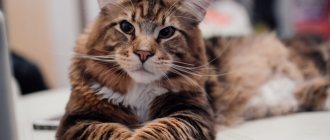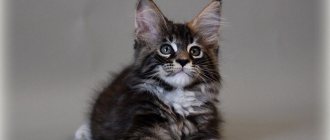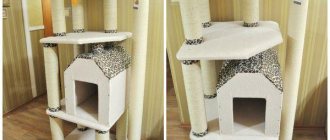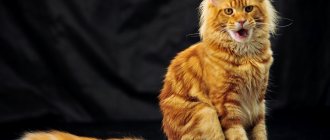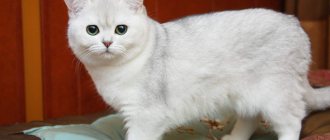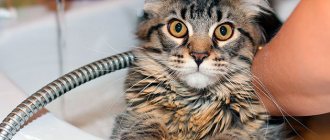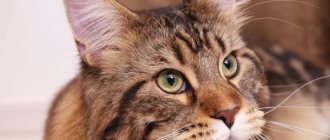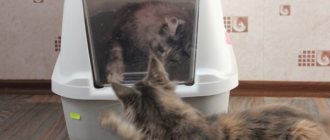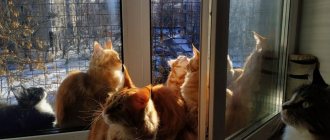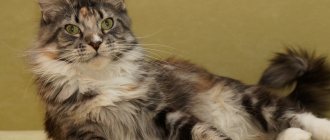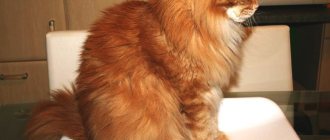Features of the breed and content
The Maine Coon requires careful grooming. Representatives of the breed are distinguished by their large bodies and long coats, which require regular grooming.
Caring for a Maine Coon at home requires a lot of time and effort. The owner must:
- bathe the cat;
- comb the fur;
- clean ears and eyes;
- examine teeth;
- take the animal for a walk;
- provide high-quality and balanced nutrition;
- carry out vaccinations in a timely manner;
- castrate your pet if there is no need for breeding.
A person who decides to become the owner of an elite cat should think about whether he will be able to devote as much time to the Maine Coon as is required for care. If not, then it is better to choose a less demanding breed.
Maine Coons are smart, neat, trainable cats that can easily guess the mood of their owner. The only drawback of the breed is the difficult care and problematic maintenance of Maine Coons.
Breed standard: appearance
If you are interested in the characteristics of the Maine Coon, breed standards and appearance, you must take into account that these cats have a large, muscular and slightly elongated body with a rectangular structure. Oval eyes are set wide apart. Their color is often combined with the color of the coat.
The size of the paws is often comparable to the parameters of the body. At the same time, the limbs are just as athletic and with well-developed muscles. There are tufts of fur between the paw pads.
The tail is particularly fluffy and voluminous. The total length of the body with tail reaches 95-100 cm.
The coat is short on the head and shoulders, but long throughout the back and belly. The animals have a thick undercoat.
The standard allows any color options, with the exception of chocolate, lilac and cinnamon.
Maine Coon weight and height by month
Maine Coons develop most actively until they are one year old. The three-month-old kitten is larger in body size than some ordinary cats. The height of an adult one-year-old individual at the withers is 25–40 cm. The length of the body (including the tail) reaches 110–120 cm. The tail itself grows up to 35 cm.
The table shows the approximate normal weight of Maine Coons at different periods of development. But don’t worry if the pet’s size is slightly smaller or larger than the norm, since the animal’s development is determined by many factors: living conditions, quality of nutrition, the number of cubs in the litter, and the health of the mother cat during pregnancy.
| age, months | female weight, kg | male weight, kg |
| 1 | 0,56–0,68 | 0,63–0,76 |
| 2 | 1,2–1,4 | 1,2–1,6 |
| 3 | 1,6–2,2 | 1,8–2,3 |
| 4 | 2,6–3,5 | 3,2–3,9 |
| 5 | 3–4 | 3,3–5,3 |
| 6 | 3,2–4 | 4–6,3 |
| 7 | 3,4–4,2 | 4–6,5 |
| 8 | 3,7–4,3 | 4,3–6,8 |
| 9 | 4–5 | 5–6 |
| 10 | 4,2–5,4 | 5,2–7,4 |
| 11 | 4,3–5,8 | 5,6–8 |
| 12 | 4,5–6,2 | 5,8–9 |
How old do Maine Coons grow?
After the Maine Coon turns one year old, weight gain gradually slows down. However, the muscles and bones are not completely formed by the first mating in males or the birth of females, as happens in other breeds. Weight gain in the breed continues up to 3 and even 4 years, especially in males. In American-type coons, maturation is even later - up to 5 years.
If a cat is untied at one year old, then he still remains a kitten by Maine Coon standards. At the same time, many owners have a concern: if they untie their pet early (before 2 years), it will stop growing. Veterinarians and breeders consider this judgment to be incorrect.
From 8 months to 1.5 years is considered the optimal age for untying a male.
If the first mating occurs after 2 years, then there are many cases of failure due to the cat’s lack of experience.
Requirements by month of life
Caring for a Maine Coon kitten is more difficult than caring for an adult. While the pet is small, the owner must carefully select the diet and monitor the animal’s weight in order to identify developmental disorders in time.
The table shows the developmental features of a Maine Coon kitten at different periods of life, and provides care recommendations for the owner.
| age, month | developmental features | care recommendations |
| 2 | the kitten begins to feed on its own, its teeth are formed | You should feed with cereals with milk, there should be 5-6 meals a day in small portions, the main food is gradually introduced, it is advisable to buy toys for sharpening teeth |
| 3 | weight grows very quickly, doubles in a month, the body stretches, the coat lengthens | You need to regularly play outdoor games with your pet, the number of meals is kept to 5–6 per day, the portions of the main food are increased |
| 4 | the kitten eats basic food, knows how to use the litter box, and remains playful | scalded or boiled meat is added to the diet |
| 6 | Maine Coon grows more slowly, the teenage stage of life begins | if breeding is not planned, the animal should be castrated |
| 8 | the cat is still growing, but the teeth are already formed, you can give solid food | dry meat, cottage cheese, and other fermented milk products are added to the diet |
| 12 | Maine Coon becomes an adult | food and care standard for the breed |
Kitten development
The weight of Maine Coon cats depends not only on the genetic reserve, but also on how responsibly the owner of the animal treats nutrition. Height and weight vary at different stages of a kitten's development, but should always be consistent with each other.
Cats are immediately born large, and the greater the weight of the newborn, the larger the adult cat grows. Surely, you are concerned about the answer to what age Maine Coons grow. Fluffy cats actively increase in size until about a year old, then such a sharp pace decreases, but development continues until 3-4 years.
The growth stages of cats can be divided into 4 periods:
- The neonatal period of life lasts 4 days.
- In the first month it is a sucker.
- Then transitional, when the cub tries adult food. About three weeks pass, while the babies, adapting to new food, reduce their indicators of physical development.
- And after the post-suction period, at this time the kittens finally switch to independent feeding.
Tray training
They buy 2-3 month old kittens from breeders who already know what a litter box is. A small pet only needs to be told where to go when needed. If the house is large, then it is advisable to place several trays in different rooms.
You can tell that a Maine Coon wants to go to the toilet by its behavior. The pet is worried, meows, and tries to find a secluded corner. And then the owner must tenderly carry the cat to the tray. If the animal does not understand where it was moved and continues to worry, then you need to carefully dig the tray filler with your fingers.
If the Maine Coon could not resist and relieved itself before being transferred to the tray, then you need to wipe the urine with a paper napkin, which is then placed in the litter. The smelling napkin will indicate to the animal where the toilet is located.
What to feed a Maine Coon kitten: recommendations
Giant cats grow slower than other breeds; the musculoskeletal system is formed up to 1.5 years. Another distinctive feature of the Maine Coon is its large, well-developed jaw. In nature, cats hunt small prey: rodents, birds, lizards. They satisfy hunger with a small amount of food, but often up to 10-15 times a day.
Pets have retained the habit and often go to the bowl throughout the day, spending a total of up to 30 minutes eating.
Natural nutrition
Kittens and adults should absolutely not be offered food prepared for people.
The diet should include:
- Meat. The best option is beef, chicken, veal, offal (unpeeled beef tripe, kidneys, lungs). Occasionally it is allowed to pamper your pet with a portion of boiled liver.
- Milk, fermented milk products - kefir, cottage cheese, yogurt, fermented baked milk. Sour cream is suitable as a delicacy; it should not be greasy. You should not give hard cheeses, feta cheese, suluguni due to the high concentration of salt in the product.
- Once every 1-2 weeks, give sea fish, boiled until half cooked, cleaned of bones. It is enough to simply boil capelin, sprat, and anchovy; there is nothing dangerous in these varieties for the esophagus and gums.
- Boiled quail eggs are preferable; they are hypoallergenic; 4-5 eggs per week are allowed.
- Cereals - rice, oatmeal, buckwheat. Valuable sources of fiber necessary for normal functioning of the stomach and intestinal peristalsis, offered once every 2-3 days. The cereal is washed, poured with boiling water, covered with a lid, letting it brew for 2-3 hours.
- Boiled, fresh vegetables - carrots, beets, broccoli, cauliflower, pumpkin, cucumbers, dried seaweed, fruits.
- Necks and heads of chickens - soft bone, brain and eye tissues help cleanse the stomach of hair, are sources of valuable microelements, remove plaque, and train the jaws. The beak is first removed.
Be sure to read:
Maine Coon: size and weight correspond to the age of the cat
Before appearing in a bowl, raw meat should lie in the freezer for 2-4 days. During this time, pathogenic bacteria and worm eggs will die in it.
With natural feeding, it is necessary to additionally give vitamin complexes and dietary supplements, since even with a well-formulated, complete diet, it is difficult to ensure that the body receives all the necessary nutrients in sufficient quantities.
You cannot give hot or cold food; it should be at room temperature, cut into portions.
Dry and wet food
A convenient and favorite way of eating by most owners. Ready-made food has a balanced composition and does not require time to purchase ingredients, preparation, or cooking.
Babies are fed premium, superpremium, holistic-class food:
- Ekanuba;
- Nutro;
- Purina Pro Plan;
Of the cheaper options, Royal Canin, Yams, and Gourmet canned food have proven themselves well.
These manufacturers create a high-quality product, balanced in protein, fat, carbohydrates, fiber, enriched with vitamin complexes, amino acids, taurine, omega 3,6 acids, and healthy food additives. The food is selected taking into account the age of the animal.
Cheap options are contraindicated for kittens and adults, as they contain mineral salts and carbohydrates in excess. For the production of Whiskas, Pan Kot, Friskas, Sheba feeds, waste meat products - feathers, bones, skins - are used. They provoke the appearance of kidney stones and cannot cover the cat’s need for nutrients.
Mixed diet
Mixed feeding is allowed. Granules are poured in small quantities, replenishing the volume as needed. When exposed to air, they lose their aroma that is attractive to pets, and in summer they quickly oxidize due to the heat. The water should be fresh, clean (filtered), and changed regularly.
Cats drink less than dogs, often do it at night and need a free opportunity to quench their thirst. Wet food becomes unsuitable for eating 3-4 hours after being removed from an open package; the bowl is filled with it strictly before eating.
Be sure to read:
Maine Coon: character and habits, maintenance and care, diseases, how to choose a kitten
Professional breeders and veterinarians are divided into two camps: some say that with this style of feeding the cat is at risk of vitamin deficiency, excess calories, and digestive system disorders. Others practice mixed feeding, considering it healthy and practical.
This method is convenient if the Maine Coon spends the whole day at home alone, and working owners have the opportunity to feed their pet natural food only in the morning and evening.
Pedigree feed lines
Leading manufacturers offer Maine Coon owners a breed-specific line of dry and wet food adapted to the characteristics of the breed.
They:
- enriched with components that maintain the coat in a presentable form, making it shiny, silky, smooth;
- have a large fraction, suitable for powerful jaws, providing a load that cleans the teeth;
- have high energy value;
- contain additives intended for the prevention of breed-specific diseases - joint dysplasia, heart pathologies.
Adapted nutrition within the line is divided according to the age of pets, health conditions: pregnant cats, lactating cats, kittens, neutered cats, etc. It is advisable to use dry and wet food from the same manufacturer for feeding.
Care
In order for the cat's appearance to remain attractive, compliance with the rules of care for Maine Coons is required. Ears, eyes and fur need special care.
Ears
Cat ears are examined regularly. The surface of healthy ears is pink.
Accumulations of sulfur are removed with a cotton swab moistened with veterinary ear drops (they are sold in pet stores). It is better not to use cotton swabs for care, so as not to accidentally injure the inner parts of the ear.
If the animal's ears are affected by mites, then drops are instilled in 2-3 drops. Or use veterinary tick powder.
Eyes
Mucus sometimes accumulates in the corners of even healthy cat eyes. Therefore, care must include cleaning the teardrops with cotton wool moistened with water or weak tea leaves.
ATTENTION! Chamomile decoction should not be used to care for cat eyes. It causes hair to fall out around the eyes.
Muzzle
Caring for the muzzle and oral cavity should be most thorough when the Maine Coon reaches 3-5 months of age and its teeth grow.
During this period, it is important not to overlook defects in the location of teeth and the structure of the jaws. The cat's oral cavity should be examined 2 times a week. If teeth or bite defects are discovered, you should take your pet to the veterinarian.
RECOMMENDATION! For proper bite development, buy small rubber toys for the kitten that it can chew.
Teeth
A positive feature of the Maine Coon breed is the rare occurrence of tartar. But despite this, it won’t hurt to buy zoological toothpaste and brush your cat’s teeth with it every day. The brush should be used with soft bristles.
Claws
Long claws cause discomfort. As they grow, they are trimmed with a nail clipper. It is important not to damage the capillaries located in the claws. Therefore, pruning is done by holding the cat's fingers at an angle to the light so that dead and living tissue is visible. For pigmented claws, only the tip is cut off.
Wool
To care for hair, buy two combs: with frequent and rare teeth. And also a massage brush, which is used on shedding days.
First, the cat is combed with a wide-toothed comb, then with a fine-toothed comb. They move in the direction of hair growth. The neck, hind limbs and tail are scratched only with sparse teeth, since the hair on these parts of the body is long and takes a long time to grow.
If tangles have formed, they are either carefully separated into parts, combed out, or cut off with nail scissors, trying to capture as little untangled fur as possible.
Character, intelligence, habits and habits of Maine Coons
It's "mainstream" to praise the impressive size of Maine coon cats, but the real beauty of this breed lies in their amazing intelligence and character.
Intelligence
In terms of intelligence, Maine Coons are not like most other breeds - they understand commands very well, are able to remember many words, and are sensitive to the intonations and emotional state of their owners; They take completely conscious actions and adapt to the rhythm of life, habits and daily routine of their owners.
They can perceive and interpret even human body language - gestures, looks and sounds. Their body language is also developed. Thus, a slight blow to the head means a particularly reverent attitude. Moreover, they communicate with humans, literally. In the communication arsenal of coons there is not only the usual meow, but also a wide range of other sounds that are completely atypical for cats - a kind of chirping, various squeaks, trills and many variations of purring.
The behavior of Maine cats directly depends on the quality of their upbringing.
Character
The key character traits of Maine Coons are neatness, peacefulness and calmness. They are not at all prone to mischief, knocking over things, or doing something out of spite. Thanks to their developed intellect, they are well aware of the boundaries of what is permitted and do not cross them.
It is generally accepted that cats view everything around them as their property. But in this sense, the Coons are an enviable exception - they divide all objects into theirs and those of others, treating the latter very carefully.
Maine cats generally behave very carefully. They do not like to climb cabinets or mezzanines, preferring to lie on the sofa or carpet. They prefer open spaces; like all predators, they instinctively strive to occupy some elevation in order to observe what is happening around them.
Maine Coons behave in many ways like dogs.
Peculiarities
These animals are very fond of water procedures in any of their manifestations. Bathing for a Maine Coon is a real holiday. This is worth remembering if you have an aquarium or other open containers of water.
Maine Coons are natural hunters, so all foreign animals within their reach will be caught, strangled and, most likely, eaten. At the same time, they are smart enough to realize the presence of other pets and not offend them, even birds and fish.
Cats of this breed are very playful, but they need a partner to play. If you have one cat, you should regularly play with him or at least allow him to spend time with you. They do not tolerate loneliness well, so it is worth making sure that the animal has something to occupy itself with, fortunately, many different toys are sold today.
A lively mind provokes a very developed curiosity in Maine Coons. If you live in a private house and let your cat out for walks, keep in mind that excessive curiosity can lead to dire consequences. And I can simply steal such a noticeable animal - you shouldn’t forget about that either.
With their love of water, Maine Coons are radically different from all other cats.
Socialization
Cats get used to their owner very quickly. They carefully study their person, adapt to the characteristics of his behavior, and learn to understand him. They single out one “main” person, but easily accept other family members and pets.
Maine Coons have a clear “friend or foe” division - they ignore and even avoid strangers who come into the house. However, after several meetings, “acquaintance” does occur, especially if the new person does not try to touch the cat. Representatives of this breed generally do not like to be picked up or placed on laps. Although these behavioral reactions may be different if the coon is accustomed to being on your hands or knees as a child. And sometimes animals themselves feel a desire to get closer to a loved one, but this still does not apply to unfamiliar people.
Maine Coons love children, take care of them and even tolerate children's pranks. It is still better to explain to the child that the kitty is alive, it may be unpleasant for her, she may defend herself. But often such problems do not arise - developed intelligence allows the kun to “forgive” a child much of what would be unforgivable for an adult.
By the way, Maine Coon males are excellent dads. They take a direct part in raising the offspring - they are not separated even from newborn kittens. Perhaps this is why they are lenient towards human cubs.
Maine Coons are highly social animals.
Water treatments
Maine Coons love to swim, so water treatments are always included in their care. However, you need to follow certain rules for bathing a cat:
- Before washing, the pet is combed, its skin is checked for wounds, and its claws are trimmed.
- For bathing, use a sink or large basin. The container is filled with warm water.
- To prevent paws from slipping and claws from leaving scratches, it is advisable to cover the bottom of the container with a rubber mat or towel.
- During washing, the owner gently holds the cat by the scruff of the neck with one hand, and rubs the pet shampoo into the fur with the other.
- They don't soap their hair.
- The foam is washed off with a shower head. The water pressure is made weak. There should be a distance of 2–3 cm between the watering can and the animal’s body.
- Do not use human shampoo.
- After bathing, the fur is dried with a towel. You can use a hair dryer if the cat is not afraid of it.
Nutrition
A Maine Coon consumes more calories per day than a regular cat, but overfeeding is unacceptable: it leads to pathologies of the joints and digestive organs. You can feed your pet both natural food and ready-made store-bought food.
When feeding natural food, the menu is carefully selected; the diet must be balanced. It includes:
- meat;
- boneless sea fish fillet;
- egg yolk;
- cottage cheese, kefir;
- milk porridge;
- vegetable stew.
You can't give your cat a treat:
- fatty meat (pork, lamb);
- sweets (including dairy);
- fatty dairy products, cream;
- bones;
- food from the master's table.
If the choice is made in favor of ready-made food, then choose high-quality, premium or holistic-class. Best options:
- Royal Canin.
- Nutra Gold.
- Josera.
- Biomill.
- Hills; Choice.
- Orijen.
Walk
The owner either lets the cat go for a walk or walks him on a leash. The first option is preferable in the countryside or in the countryside, the second is safer in the city, since a stray Maine Coon can get hit by a car or end up in the hands of bad people. For walking in the city, choose parks, squares, and other quiet and secluded places.
IMPORTANT! Before a walk, the fur is treated with flea spray, or the cat is given a protective collar. After walking the pet, give it a bath.
Periods of development
This factor largely determines how correctly the Maine Coon’s weight will change over the months.
- Neonatal period. Its duration is only four days. Weight gain at this time varies and primarily depends on the progress of labor.
- The suckling period lasts four weeks. At this time, you can observe a stable and uniform weight gain (on average 35 g/day). In four weeks, the kitten should gain 500-800 g.
- The transition period lasts from the fourth to the eighth week. The kitten's feeding changes. Weight gain slows down slightly by week 5. This is due to the transition to solid food. But by the seventh week the weight begins to increase.
- The post-suction period lasts from 8 weeks until the cat’s growth is complete.
Diseases and prevention
Maine Coons have a fairly strong immune system, but their health is affected by nutrition and care. If not properly cared for, a cat can get sick:
- indigestion;
- urolithiasis;
- joint pathologies;
- infectious inflammatory diseases;
- helminthiasis.
The breed is also characterized by genetic pathologies that manifest themselves in both kittens and mature individuals:
- hypertrophic cardiomyopathy;
- spinal muscular atrophy;
- dysplasia of the joints of the hind limbs;
- polydactyly (six-fingered).
To keep the Maine Coon healthy, care should include annual vaccinations against rabies, rhinotracheitis, panleukopenia, calcivirosis, and periodic treatment for worms, ticks and fleas. To keep the coat shiny and the teeth and claws to remain strong, the cat is given vitamin supplements.
NOTE! How long a Maine Coon lives depends on care and quality of food. With proper care, a cat can live up to 13–15 years. Some individuals reach 18–20 years of age.
First month
The first month is the most important period in the life of a little Maine Coon. Every day he must gain a certain amount of weight: in the first days - up to 10 g, in the second or third week - from 20 to 50 g.
By the end of the fourth week, the weight of males ranges from 620 to 750 g, females - from 520 to 650 g.
Important: The weight of newborn kittens does not depend on gender. Males and cats should have approximately the same weight. If your pet's weight is too low, it indicates health problems.
Keeping a Maine Coon in an apartment
To make keeping the Maine Coon comfortable, the owner should buy:
- Tray.
- Device for sleeping and resting: a bed, a house or a decorative mattress.
- A scratching post in the form of a pillar or pillow.
- Bowls for food and water. Choose durable plastic, metal or ceramic products. They are placed in the kitchen.
- Play corner with various toys. Maine Coons love vertical multi-story structures that they can climb up and down. It is advisable to lay a soft carpet under the corner so that the cat does not hit himself when jumping down from a height.
The Maine Coon is a high-maintenance breed. The owner must choose high-quality food, care for the pet’s long hair, and remember about annual preventive veterinary measures. And then the handsome furry will remain healthy and active for many years.
Did you like the article?
Maine Coon Health and Diseases
Big cats are characterized by good endurance and resistance to many diseases. They are not afraid of heavy loads and can easily tolerate living in harsh climatic conditions. With proper care, life expectancy reaches 12-15 years.
The main danger to feline health is hypertrophic cardiomyopathy. The disease affects the heart and is characterized by a complex course. It affects old pets who have reached 8-10 years of age.
Animals undergo spinal muscular atrophy, which affects the spinal cord. The main symptoms are the inability of muscle joints to perform their functions.
Cats often suffer from polycystic kidney disease. The pathology manifests itself in the form of degeneration of the kidney parenchyma into a malignant tumor. It is almost impossible to cure it, so specialists use supportive therapy methods in an attempt to prolong the pet’s life and alleviate its condition.
Maine Coons are beautiful and graceful cats that are distinguished by their loyalty and wit. They are big and friendly. In order for the pet to feel comfortable, and for its growth and development to proceed without deviations, it is important to monitor the basic subtleties of keeping it, providing it with care and attention.

